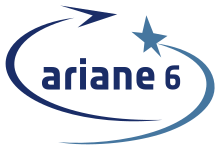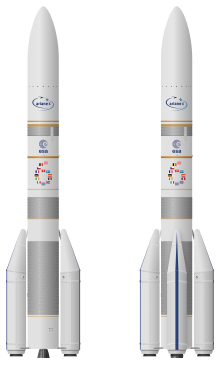
Ariane 6
European space launch vehicle under development / From Wikipedia, the free encyclopedia
Dear Wikiwand AI, let's keep it short by simply answering these key questions:
Can you list the top facts and stats about Ariane 6?
Summarize this article for a 10 years old
Ariane 6 is a European expendable launch system under development since the early 2010s by ArianeGroup on behalf of the European Space Agency (ESA). It replaces the Ariane 5, as part of the Ariane launch vehicle family. The stated motivation for Ariane 6 (as of 2015) was to halve the cost compared to Ariane 5, and increase the capacity for the number of launches per year (from six or seven to up to eleven).[6]
 | |
 Illustration of the two Ariane 6 variants planned, A62 (left) and A64 (right) | |
| Function | Medium-heavy launch vehicle |
|---|---|
| Manufacturer | ArianeGroup |
| Country of origin | European Space Agency |
| Project cost | €3.6 billion[1] |
| Cost per launch | €75 million (Ariane 62) €115 million (Ariane 64)[2][3] |
| Size | |
| Height | 63 m (207 ft) |
| Diameter | 5.4 m (18 ft) |
| Mass | 530,000–860,000 kg (1,170,000–1,900,000 lb) |
| Stages | 2 |
| Capacity | |
| Payload to LEO | |
| Mass | A64: 21,650 kg (47,730 lb) A62: 10,350 kg (22,820 lb)[4] |
| Payload to GTO | |
| Orbital inclination | 6° |
| Mass | A64: 11,500 kg (25,400 lb) A62: 4,500 kg (9,900 lb)[4] |
| Payload to GEO | |
| Orbital inclination | 0° |
| Mass | A64: 5,000 kg (11,000 lb)[4] |
| Payload to SSO | |
| Orbital inclination | 97.4° |
| Mass | A64: 15,500 kg (34,200 lb) A62: 7,200 kg (15,900 lb)[4] |
| Payload to LTO | |
| Mass | A64: 8,600 kg (19,000 lb) A62: 3,500 kg (7,700 lb)[4] |
| Associated rockets | |
| Family | Ariane |
| Comparable | Vulcan Centaur, H3, Titan IV, Falcon 9, Falcon Heavy (reusable) |
| Launch history | |
| Status | In Development |
| Launch sites | Centre Spatial Guyanais |
| First flight | 2024 (planned)[5] |
| Boosters – Equipped Solid Rocket | |
| No. boosters | 2 or 4 |
| Diameter | 3 m (9.8 ft) |
| Propellant mass | 142,000 kg (313,000 lb) |
| Powered by | P120 |
| Maximum thrust | 4,650 kN (1,050,000 lbf) each |
| Core stage – Lower Liquid Propulsion Module | |
| Diameter | 5.4 m (18 ft) |
| Propellant mass | 140,000 kg (310,000 lb) |
| Powered by | Vulcain 2.1 |
| Maximum thrust | 1,370 kN (310,000 lbf) |
| Propellant | LH2 / LOX |
| Upper stage – Upper Liquid Propulsion Module | |
| Diameter | 5.4 m (18 ft) |
| Propellant mass | 31,000 kg (68,000 lb) |
| Powered by | Vinci |
| Maximum thrust | 180 kN (40,000 lbf) |
| Propellant | LH2 / LOX |
Ariane 6 is designed with two stages, both powered by liquid hydrogen-liquid oxygen (hydrolox) engines. The first stage has an improved version of the Vulcain engine already used on the Ariane 5, whilst the second stage has a newly designed Vinci engine. Most of the initial lift-off thrust is provided by solid rocket boosters attached to the first stage: either two or four P120s (Ariane 62 and Ariane 64 variants respectively), which are larger versions of the P80s used on the Vega rocket.
Selection of the design concept was made by ESA in December 2014,[7] favouring it over an alternative all-solid-fuel rocket option.[8] Further high-level design was completed in 2015 and the vehicle entered the detailed design phase in 2016. In 2017, the European Space Agency (ESA) set 16 July 2020 as the deadline for the first flight,[9] and in May 2019 Arianespace placed the first production order. Following a sequence of additional program delays to 2022 and then 2023, as of August 2023[update] Arianespace has said that the first launch attempt will not occur until 2024.[5]